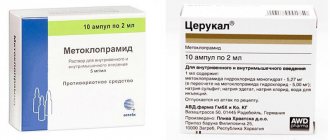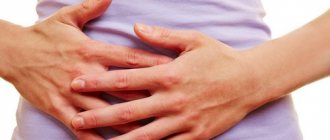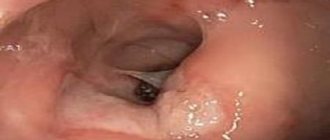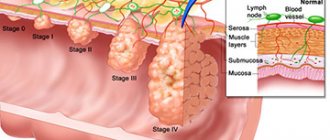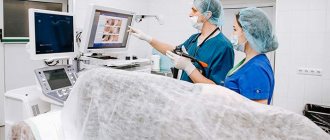General information
Proctitis is an inflammation of the rectum of various origins. The rectum is the last section of the intestine, which performs the function of evacuating already digested food. The rectum has an internal/external anal sphincter that contracts to retain feces and relaxes during bowel movements. The intestine ends with the anus (Fig. below).
The rectal wall consists of muscles that control the complex act of defecation, initiated by peristalsis of the sigmoid colon when the maximum volume of feces/gas is achieved by stimulating the receptors of the intestinal wall. The mucous membrane contains many nerve endings that are involved directly in the process of defecation. In addition, the rectal mucosa produces special mucus containing digestive enzymes that promote the process of residual digestion of food, and also acts as a lubricant that facilitates the passage of feces.
The inflammatory process in the rectum can be limited only to the distal part of the rectum or anus, in which the inflammatory process predominantly affects the tissue of the sphincter (obturator orbicularis muscle). This variant is often called "anusitis"/"anitis". In cases of damage to the anal mucosa, the pathological process may involve Morgani's crypts ( cryptitis ) or also the anal papillae ( papillitis ). To a certain extent, inflammation can spread to the sigmoid colon ( proctosigmoiditis ), less often (in 10-30% of cases) to the large intestine with the development of ulcerative necrotizing colitis . Often proctitis is combined with paraproctitis .
There are no exact data on the distribution of isolated colitis. Despite the fact that in general, inflammatory bowel diseases are inferior to other diseases of the digestive system in terms of incidence/prevalence level, but in terms of the frequency of complications, severity and mortality, they occupy one of the leading positions in the world in the structure of gastrointestinal diseases.
Symptoms of chronic proctitis
In this form, exacerbations alternate with periods of remission. The main criterion for diagnosis is the course of the disease for more than 6 months.
The clinical picture without an exacerbation is erased - most often, it is limited to a periodic feeling of discomfort in the rectum. Since chronic proctitis often occurs against the background of another disease, the symptoms associated with this pathology come to the fore for the patient.
Symptoms and treatment of proctitis during an exacerbation are similar to the acute form.
Pathogenesis
Despite the fact that the pathogenesis of proctitis in most cases is based on an inflammatory process, the etiological features of its development determine its specificity, which is not possible to consider within a short article. Therefore, we will consider only the pathogenesis of radiation proctitis , which is based on the activation of the cytokine system in the mucous-submucosal layer of the intestine, which is caused by the massive destruction of tissue cells during the irradiation process. As a result, a cascade of reactions is launched that promotes the development of inflammatory changes in the walls of blood vessels.
Ischemia of the mucous-submucosal lining of the rectum occurs and increases to a critical state with gradually progressive atrophy and fibrosis of the submucosal layer (often with necrotic changes), the end result of which is bleeding from telangiectasias (newly formed vascular plexuses), the formation of recto-vesical / recto-vaginal fistulas and rectal strictures .
Classification
The classification of proctitis is based on various signs.
According to the duration of the disease/morphological features, inflammation of the rectum is divided into acute and chronic.
Acute proctitis, which in turn, according to characteristic changes in the rectal mucosa, is divided into:
- catarrhal-hemorrhagic (edematous mucosa/presence of hemorrhages);
- catarrhal-purulent (presence of purulent plaque on the mucous membrane);
- polyposis (growth of polyps on the rectal mucosa);
- erosive (there are surface defects on the mucosa).
- ulcerative (ulcers of different sizes form on the mucous membrane);
- ulcerative-necrotic (ulcers and local areas of mucosal necrosis are present on the mucosa).
Chronic proctitis, which is divided according to the condition of the mucous membrane into:
- normotrophic (mucosa without noticeable changes);
- atrophic (folds of the mucous membrane are thinned/smoothed);
- hypertrophic (folds of the mucous membrane are loose and thickened).
According to the etiology, there are nutritional, stagnant (with constipation of various origins), radiation (with radiation therapy), infectious, parasitic, chlamydial, gonorrheal and other proctitis.
Causes and types of inflammation
As a rule, the symptoms of inflammation of the rectum and its treatment with folk remedies directly depend on the factors that caused the disease. Among these are the following reasons:
- mechanical damage to the mucous membrane;
- hemorrhoids and varicose veins of the rectum;
- formation of anal fissures;
- constipation and defecation disorders;
- poor nutrition and digestive disorders;
- infectious and inflammatory diseases of other organs nearby;
- venereal diseases and diseases of the genitourinary system;
- undergoing radiation therapy.
Among the representatives of pathogenic flora that provoke inflammation in the rectum are tuberculosis bacteria, pale spirochetes, gonococci and helminths. Also, the cause of inflammatory processes in the intestines can be a recent surgical operation in the anus.
Depending on how the disease progresses, you can determine its form - acute or chronic . Acute inflammation, as a rule, occurs with constant symptoms, which go away over time; chronic inflammation is characterized by periodic return of symptoms, but not so pronounced.
Acute proctitis can be very different; among the main types of inflammation of the rectum are the following:
- hemorrhagic;
- purulent;
- slimy;
- polyposis;
- erosive;
- ulcerative;
- ulcerative-necrotic;
- fibrous.
The chronic form has milder symptoms , which, however, can cause inconvenience for many years. The course of the disease in this form consists of periods of exacerbation and remission, and also serves as the basis for the differences between other chronic infections, systemic diseases of the body, or even cancerous tumors.
Before treating the rectum, you should understand what type of inflammation needs to be treated. Chronic proctitis can be divided into several forms. From the first to the last form, the level of hyperemia, redness and swelling gradually decreases:
- Hypertrophic . In this case, the rectal mucosa begins to increase in size, forming folds.
- Normotrophic . The mucous membrane is inflamed, but its shape does not change.
- Atrophic . The walls of the mucous membrane become thinner, the villi are smoothed out, and the smooth muscles of the intestinal walls work sluggishly.
Causes
Proctitis is a polyetiological disease that develops under the influence of various causes, the main of which include:
- Various types of errors in nutrition (eating disorders, abuse of spicy, salty and spicy foods, smoked foods, fatty foods, alcohol abuse, etc.).
- Mechanical trauma to the rectum (anal intercourse, damage to the rectal mucosa when rough/hard objects are inserted into the anus), rectal surgery for paraproctitis , hemorrhoids / anal fissure .
- Chronic constipation with stagnation of venous blood in the walls of the rectum, which leads to trauma to the mucous membrane and the development of congestive proctitis.
- Damage to the mucous membrane by various irritating substances (enemas with potassium chloride, table salt, iodine, mustard tincture, boric acid). Abuse of enemas, especially when treated with folk remedies, use of too cold/hot solutions.
- Infestation by parasites ( amoebiasis , giardiasis , enterobiasis , ascariasis ), specific infection ( gonorrheal / syphilitic proctitis ).
- Intestinal infections ( dysentery , campylobacteriosis ).
- Inflammatory diseases of the pelvic organs ( prostatitis , vulvovaginitis , cystitis , pouch of Douglas abscess ), non-inflammatory diseases of the rectum of nature ( hemorrhoids ).
- Autoimmune proctitis (with amyloidosis , Crohn's disease , ulcerative colitis ).
- Radiation therapy. Proctitis is caused by excessive intense irradiation, mainly of the pelvic area in patients with oncological pathology ( prostate cancer , / cervical cancer , rectal cancer , etc.).
Treatment of proctitis
If you notice any symptoms, you should immediately seek advice from a specialist. There is no point in postponing a visit to the doctor until later, because... there is a high risk of developing this disease against the background of rectal cancer, microfissures of the anus or hemorrhoids.
The disease is diagnosed after rectal examination and rectoscopy.
The degree and nature of inflammation can be determined by cytological examination of stool and biopsy of the rectal mucosa.
Treatment of proctitis at an early stage is more effective, because allows you to protect yourself from diseases of the digestive tract, metabolism, and gastric acidity disorders, which are inherent in the chronic form of inflammation of the rectum.
Treatment usually includes the use of anti-inflammatory ointments and suppositories, mainly of herbal composition. The medicinal components are quickly absorbed into the rectal tissue and normalize its activity.
When treating, it is important to establish the true cause of the disease. Sometimes, without knowing exactly the cause of the disease, it is recommended to use complex treatment methods.
For effective treatment, the patient only needs to strictly follow the doctor’s recommendations.
Treatment of severe forms of proctitis is carried out only in a hospital under the supervision of doctors. After antibiotic sensitivity testing, anti-inflammatory therapy with antibiotics and sulfonamides is recommended.
For very severe forms of ulcerative proctitis, treatment with corticosteroids is indicated.
Narrowing of the rectum can only be treated surgically.
Symptoms of proctitis
The symptoms of proctitis are largely determined by its form. In the acute course of proctitis, the symptoms of inflammation of the rectum are significantly pronounced. The disease usually begins suddenly, the patient feels a strong burning sensation in the rectum, a feeling of heaviness/pain in the perineum, aggravated by bowel movements; Tenesmus (false urge) is characteristic.
Diarrhea is observed , in some forms with an admixture of mucus/pus/blood in the stool. The general condition suffers: body temperature rises, chills appear less often.
Catarrhal proctitis
The disease manifests itself as a pain syndrome, which is initially concentrated in the rectal area and intensifies during defecation, and then the pain moves to the perineal area of the scrotum/labia, and in some cases radiates to the back. Patients complain of a frequent urge to defecate, and instead of feces, mucus is released, sometimes with the presence of pus/blood, and the nature of the discharge is directly determined by the form of catarrhal proctitis.
Catarrhal proctitis is accompanied by an increase in temperature to subfebrile/febrile levels. Against the background of fever, symptoms of general intoxication gradually develop: weakness, loss of appetite, headaches, fatigue, and, less often, nausea. Constipation may occur, periodically followed by diarrhea. Acute catarrhal proctitis usually develops over several days. Visual irritation/redness in the anus; upon digital examination, sharp pain and mucus discharge (with pus/blood).
Erosive proctitis
Erosive proctitis is characterized by a sudden onset, false urges, with increased body temperature, chills, pain in the rectum, less often with irradiation to the perineum, lower back, and sacral area. Patients complain of burning, itching and a feeling of heaviness in the anus. Acts of defecation become more frequent, and the stool becomes liquid with the appearance of blood/mucus in the stool. Less commonly, with erosive proctitis, discharge of bloody mucus is noted against the background of tenesmus without fecal impurities. There may be a gaping of the anus with the discharge of liquid feces, mucus/blood.
The severity of clinical symptoms is largely determined by the type of erosive proctitis, as well as the prevalence of the inflammatory process. Thus, with gonorrheal proctitis , the symptoms are mildly expressed in the form of moderate burning/itching and mild pain with rare false urges. While with erosive radiation proctitis there is a severe course with severe pain, hyperthermia and frequent tenesmus.
Ulcerative proctitis
Ulcerative proctitis proceeds similarly to the symptoms of erosive gastritis with a sudden onset, weakness, weakness, hyperthermia , tenesmus , itching, burning and pain in the anus. The stool becomes liquid, and as the disease progresses, the intervals between bowel movements become shorter. In some cases, there is a continuous urge with the discharge of liquid, bloody feces in small quantities or mucus/blood without fecal matter. Ulcerative proctitis is characterized by a significantly more severe course and the presence in the stool of a large amount of red blood, which is contained in the form of visible inclusions in liquid fecal masses or is located on the surface of formed stool.
Radiation proctitis
Acute radiation proctitis is manifested by diarrhea, periodic painful tenesmus, the presence of mucus/blood in the stool, pain in the rectum, radiating to the perineum. Radiation proctitis is characterized by a violation of the general condition: weakness, loss of appetite, and increased body temperature. The specific feature is regression of symptoms a few days after antitumor therapy. Endoscopic examination reveals multiple ulcerations in the rectum/sigmoid colon, fibrosis and atrophy of the mucosa, strictures / telangiectasia , as well as contact bleeding.
Chronic proctitis
Chronic proctitis during an exacerbation occurs with mild symptoms in the form of discomfort, mild burning/itching, a feeling of incomplete bowel movement, slight pain, rare tenesmus and the presence of pathological impurities in the feces. An increase in temperature is noted. Chronic proctitis during remission can be generally asymptomatic or manifest itself with extremely mild symptoms. Often a slight/moderate amount of mucus in the stool is the only symptom of the disease.
Symptoms of acute proctitis
As a rule, signs of the acute form appear immediately or several hours after the action of the damaging factor (with the exception of tumors). Patients are concerned about two main symptoms:
- The pain is of a pulling nature, of medium or low intensity, which intensifies during bowel movements. Patients often cannot name the exact location of the pain and point to the lower abdomen or lower back. However, upon active questioning, it turns out that the unpleasant sensations are located in the area of the sacrum or anus. They do not go away during the day, which leads to anxiety and increased irritability of the patient. The pain syndrome decreases somewhat after taking anti-inflammatory drugs (Ketorolac, Ibuprofen, Nimesulide) or combination drugs (Baralgin, Spazmalgon);
- Violation of the act of defecation - the patient constantly “pulls to go to the toilet” (false urge). Due to the frequency of defecation, the stool becomes mucous in nature; only mucus (a small amount) mixed with blood can be released. Constipation may develop due to a psychological block - the patient is afraid to go to the toilet, as this provokes increased pain.
Symptoms of acute proctitis can be supplemented by a decrease in appetite, a short-term increase in temperature (no more than 37.6 ° C), and discomfort in the abdominal area (due to impaired motor skills).
Tests and diagnostics
The diagnosis of “proctitis” is established based on the patient’s complaints, medical history, the results of a visual examination of the anus, a digital examination of the rectum, as well as data from stool tests (bacterial stool examination, coprogram, stool analysis for worm eggs) and instrumental research methods (sigmoidoscopy ). If necessary, PCR/ELISA diagnostics are performed for a specific infection ( syphilis , gonorrhea ). Proctitis is differentiated from paraproctitis , hemorrhoids , rectal fissure , polyposis .
Diagnosis of erosive proctitis
The patient's examination begins with an examination of the rectum, anamnesis, sigmoidoscopy and stool analysis.
Palpation examination of the anus is carried out on a gynecological chair.
During endoscopic procedures, the condition of the sphincter and mucous membranes of the rectum is assessed, enlargement of internal hemorrhoids, anal fissures and other diseases that contribute to the appearance of shallow defects are detected.
An external examination of the perianal area reveals traces of blood and feces, foci of inflammation that arise from the spontaneous release of rectal contents.
During sigmoidoscopy, swelling of the mucous membranes of the large intestine, the presence of erosions and redness are determined. A fibrous-purulent plaque is found on the walls.
The number and size of ulcers in erosive proctitis can vary - from small single lesions to extensive multiple lesions covering most of the rectum.
The inflammatory process can occur in the lower part of the organ, or spread to the entire organ, involving the sigmoid part.
To identify the cause of the disease, a blood test is performed to look for bacteria and parasite eggs.
During pregnancy
Distal colitis (proctosigmoiditis/proctitis) during pregnancy proceeds similarly to that in non-pregnant women. It is important that childbirth with proctitis occurs with minimal severity of symptoms (that is, symptoms in acute proctitis should be stopped as much as possible, and in cases of chronic proctitis, childbirth should take place in the stage of remission of the disease).
Treatment of the disease during pregnancy is carried out similarly; the use of mesalazine during pregnancy is not limited, and the dose of mesalazine is not reduced. As evidenced by numerous reviews (forum for pregnant women), childbirth with inflammatory bowel diseases, including isolated proctitis, in most cases occurs without complications.
Diet
Diet for proctitis, along with hygienic procedures and drug therapy, is the most important component of treatment, which is based on therapeutic Tables No. 3 , 4 ( 4a , 4b ) and is specifically determined by the type of functional disorders present - diarrhea/constipation. The basis of therapeutic nutrition for acute proctitis/complications of chronic proctitis is maximum mechanical/chemical sparing of the rectal mucosa. This requirement is achieved by eliminating all irritating foods from the diet.
First of all, the consumption of food containing plant fiber, which irritates the intestinal mucosa and increases gas formation, is limited: all spicy/spicy/fried foods, pickles, smoked legumes, salads and canned vegetables are completely removed from the daily diet. Freshly prepared juices, fruits/berries, sweets, chocolate, bran, seeds, dried fruits, and nuts are excluded. Drinking alcoholic and carbonated drinks is strictly prohibited.
The basis of nutrition is soups in non-concentrated chicken/vegetable broth, well-cooked porridge in water, soft-boiled chicken eggs, semi-liquid dishes, boiled fish/steamed meat, steamed cutlets, cottage cheese, low-fat yogurt, kefir, jelly, rosehip decoction. Bread - in the form of crackers or stale white. Fruit: baked apples. The amount of fluid consumed should be 1.5-2.0 l/day.
During the remission stage, the diet is expanded by including kefir and sour cream, vegetables/fruits (carrots, potatoes, cabbage, plums, strawberries, apples) consumed in moderation. In case of diarrhea, it is necessary to include in the diet foods that help slow down intestinal motility: mashed potatoes, mucous, pureed dishes (non-concentrated soups, minced meat dishes, pureed porridges, pureed rice, jelly, jelly), as well as products with an astringent effect - strong tea, quince decoctions, pomegranate peel, dogwood, bird cherry, pear, lingonberry, blueberry.
In cases of constipation, the diet includes foods that help activate the motor function of the intestine, as well as promote the act of defecation: foods that contain coarse plant fiber: wholemeal bread (bran, grain), cereals, sauerkraut, vegetables/berries/fruits, dried fruits (figs, prunes), muesli, as well as vegetable oils. It is recommended to increase the amount of fluid consumed to 2-2.5 l/day through mineral water, green/herbal tea, apricot, plum, carrot, pumpkin and peach juices. Taking bifido-drugs is indicated.
Prevention
Preventive measures include:
- A healthy balanced diet without abuse of alcohol, various herbs/spices, spicy and fried foods.
- Maintain hygiene of the anal area and genitals.
- Sexual intercourse only with barrier contraception.
- Avoiding anal injury/hypothermia.
- Adequate physical activity, especially when sitting for a long time.
- If signs of inflammatory diseases of the pelvic organs appear, it is imperative to consult a doctor.
Causes of erosive proctitis
Erosive proctitis of the rectum is considered a polyetiological disease, the development of which can be caused by septic and aseptic inflammatory processes. Adults are more susceptible to it than children.
The disease requires immediate treatment due to the possibility of complications - ulceration and narrowing of the rectum, precancerous conditions.
Proctitis is classified based on the causes of its occurrence:
The alimentary form develops against the background of frequent consumption of spicy, fried and salty foods, as well as alcoholic beverages. Erosions are formed due to the effect of an irritating substance on the intestinal mucous membranes.
Congestive proctitis is diagnosed in people suffering from constant constipation. Associated with damage to the mucous membranes of the rectum by solid feces and blood retention in the pelvic veins.
The parasitic form of the disease develops against the background of helminthic infestations, bacterial and protozoal infections. Most often it is diagnosed in people who have previously suffered from dysentery, trichomoniasis, balantidiasis, enterobiasis and ascariasis.
The occurrence of the inflammatory process is facilitated by tissue damage when helminths penetrate the mucous membranes.
Substances released by parasites during their life also have an irritating effect.
Radiation proctitis is found in patients who have undergone radiotherapy for malignant tumors of the uterus or ovaries. The most common are inflammatory processes that occur during contact radiation therapy.
Less commonly diagnosed are proctitis that develops as a result of radiography or external gamma irradiation.
Specific forms arise against the background of a long course of sexually transmitted infections - trichomoniasis, gonorrhea, chlamydia.
In women, this disease develops due to the entry of infected vaginal discharge into the anal area.
Homosexual men become infected through non-traditional sexual contacts.
Ulcerative proctitis can develop as a result of mechanical damage, thermal or chemical burns that occur when enemas are administered incorrectly or colonoscopy is performed.
Provoking factors are considered to be: diseases of the digestive system and genital organs, hypothermia, weakening of the body's defenses, anal fissures, hemorrhoids.
List of sources
- Vorobyov G.I., Zaitsev V.G. Incidence of the population with diseases of the colon, anal canal and perineum // Current issues of coloproctology. - Ufa, 2007. - P. 550-554.
- An V.K., Rivkin V.L., Solomka A.Ya. Dangers, complications and errors in proctology. - M., 2011. -112 p.
- Tkachev A.V., Mkrtchan L.S., Nikitina K.E., Volynskaya E.I. Inflammatory bowel diseases: at the crossroads of problems // Practical. medicine. 2012. T. 58. No. 3. P. 17–22.
- Valuyskikh E.Yu., Svetlova I.O., Kurilovich S.A., Osipenko M.F., Maksimov V.N., Voevoda M.I. Clinical and genetic aspects of inflammatory bowel diseases. Russian Journal of Gastroenterology, Hepatology and Coloproctology. - 2008. - T. 18. - No. 6. - P. 68-74.
- Radiation (radiation) damage to the intestine / Burkovskaya V.A. // Gastroenterology of St. Petersburg - 2013 - No. 3-4.
